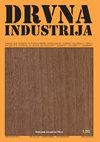交叉椅座榫卯节点的弯矩
IF 0.8
4区 农林科学
Q4 MATERIALS SCIENCE, PAPER & WOOD
引用次数: 1
摘要
本文研究了座椅底座节点的弯矩。根据测得的最大施加载荷(最大力)计算的极限弯矩(最大力矩),对椅子底座的前腿和后腿关节进行了比较。担架和腿之间的关节具有不同的角度(关节角度)以及不同的榫头长度(30mm和32mm)。试验结果表明,对于不同的试样配置,但榫槽几何形状相同的情况,对于所有榫槽长度,具有较小角度的接头(前腿接头)的最大力高于具有较大角度的接头的最大力。然而,结果显示,所分析的接头组的计算弯矩之间的差异较小。对于所有榫头长度,接头角度值较小的接头的弯矩与角度较大的接头的力矩之间没有显著差异。对于后腿关节,确定了榫长为30mm和榫长为32mm的弯矩之间的显著差异,而对于前腿关节则没有。所提出的通过测试不同形状和尺寸的试件进行接头强度分析的方法适用于研究和实践。本文章由计算机程序翻译,如有差异,请以英文原文为准。
Bending Moment of Mortise-and-Tenon Joints in a Crossed Chair Base
This paper investigated the bending moment of chair base joints. The ultimate bending moments (maximum moment), calculated on the base of the measured maximum applied loads (maximum force), were compared for the front leg and rear leg joints of a chair base. The joints had different angles between the stretcher and the leg (joint angle) as well different tenon lengths (30 mm and 32 mm). The results of the tests indicated that for different test specimen configurations but the same tenon-and-mortise geometry, the maximum force of joints with a smaller value of joint angle (front leg joints) was higher than the force values of joints with a larger angle (rear leg joints) for all tenon lengths. However, the results showed less difference among the calculated bending moments of the analysed sets of joints. A significant difference was not revealed between the bending moments of joints with a smaller value of joint angle and the bending moments of joints with a larger angle for all tenon lengths. A significant difference between the bending moments for the tenon length of 30 mm and tenon length of 32 mm was determined for rear leg joints but not for front leg joints. The presented approach of joint strength analysis through the testing of specimens with different shapes and dimensions are applicable to research and practice.
求助全文
通过发布文献求助,成功后即可免费获取论文全文。
去求助
来源期刊

Drvna Industrija
MATERIALS SCIENCE, PAPER & WOOD-
CiteScore
1.80
自引率
9.10%
发文量
32
审稿时长
>12 weeks
期刊介绍:
"Drvna industrija" ("Wood Industry") journal publishes original scientific and review papers, short notes, professional papers, conference papers, reports, professional information, bibliographical and survey articles and general notes relating to the forestry exploitation, biology, chemistry, physics and technology of wood, pulp and paper and wood components, including production, management and marketing aspects in the woodworking industry.
 求助内容:
求助内容: 应助结果提醒方式:
应助结果提醒方式:


